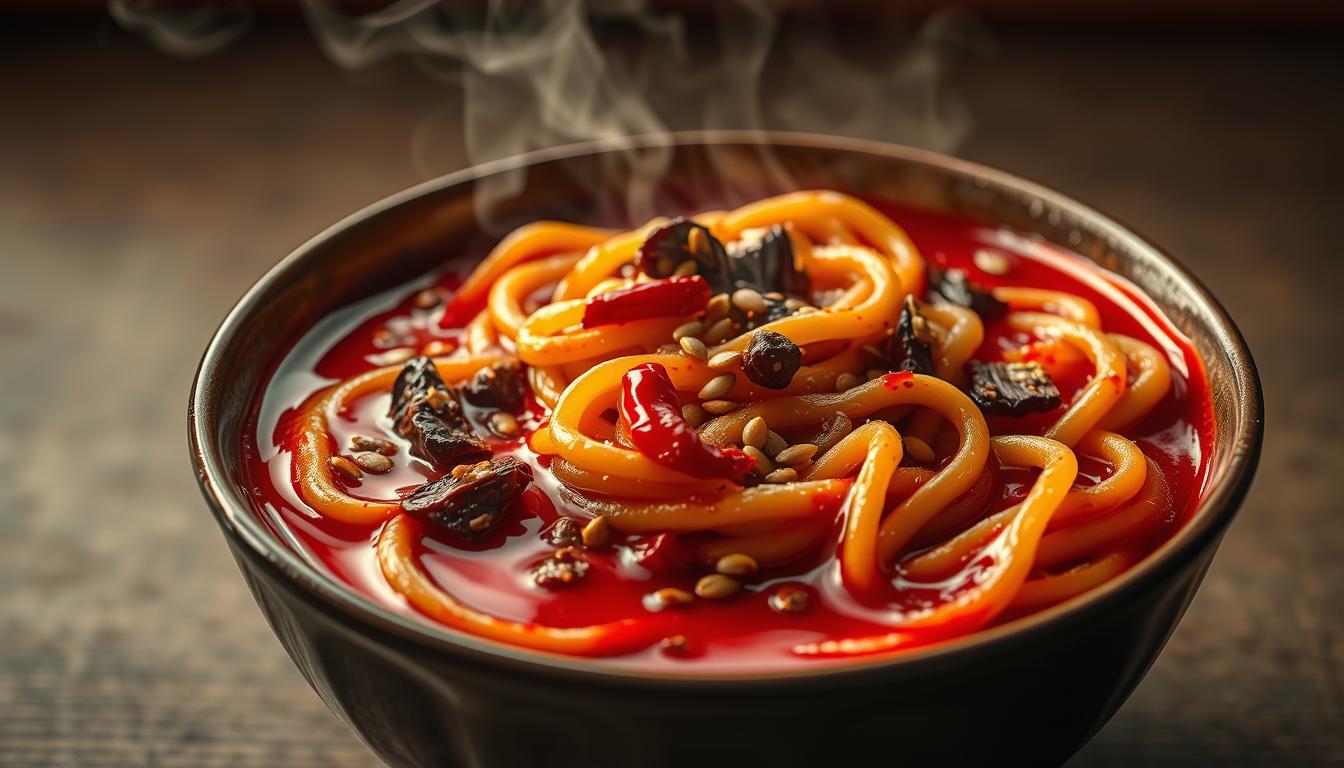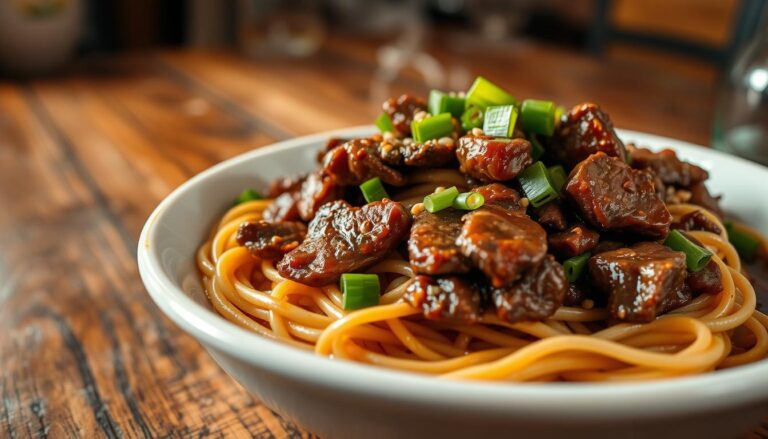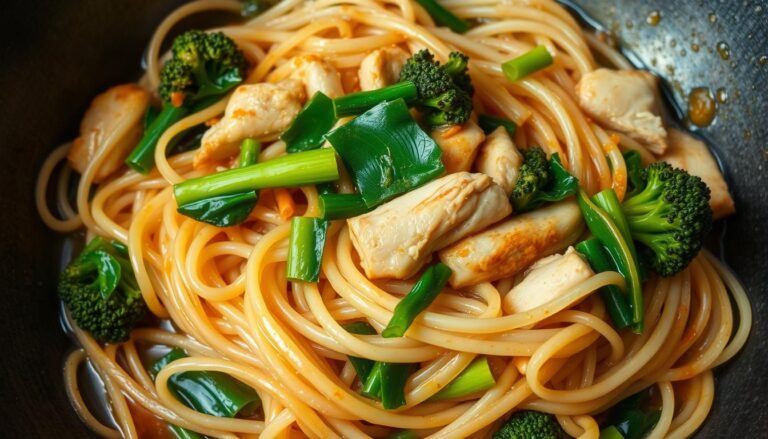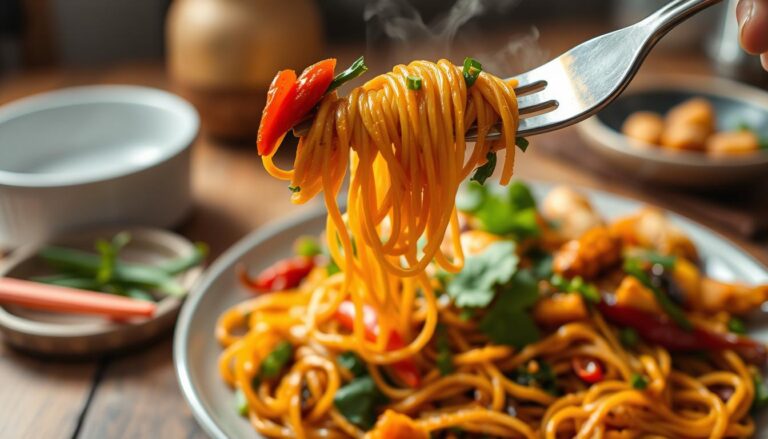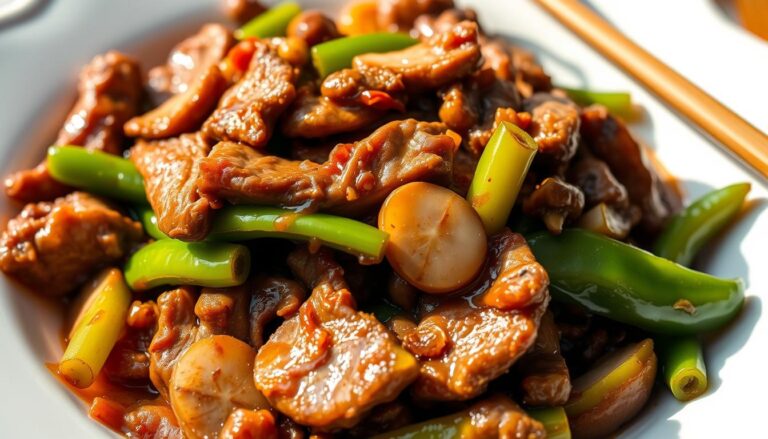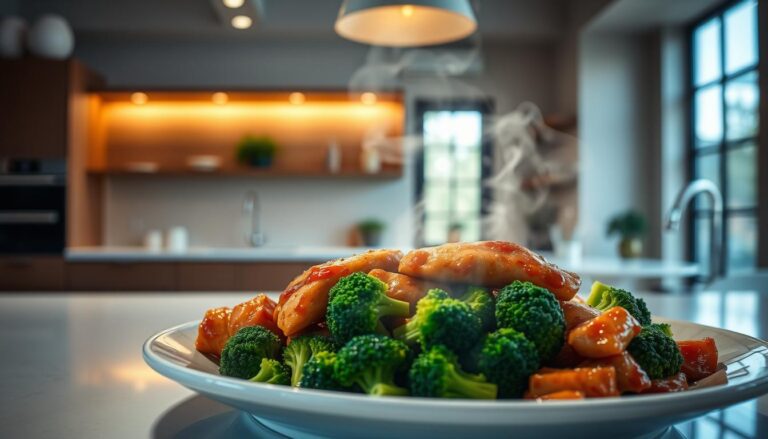Quick & Flavorful 10-Minute Chili Oil Udon Noodles
Craving a bold, satisfying meal but short on time? This 10-minute chili oil udon noodles recipe delivers restaurant-quality flavor with minimal effort. Perfect for busy weeknights or spontaneous cravings, it combines thick, chewy udon noodles with a punchy sauce that balances heat, tang, and umami.
The magic lies in the texture of udon noodles—their soft yet springy bite pairs perfectly with the spicy, savory sauce. While udon is ideal, you can swap in ramen or other noodles if needed. Customization is key: adjust the chili oil for more heat or add sesame seeds for crunch.
At the heart of this dish is a well-balanced sauce featuring chili oil, soy sauce, and rice vinegar. Garlic and green onions add freshness, while a touch of sugar rounds out the flavors. Ready in the time it takes to boil water, this recipe proves fast meals don’t have to sacrifice taste.
Key Takeaways
- Ready in 10 minutes with minimal prep work
- Udon noodles provide a thick, comforting base
- Customizable spice level and toppings
- Features a bold sauce with chili oil and soy sauce
- Works with ramen or other noodles in a pinch
- Balances heat with tangy rice vinegar and sweetness
Introduction to This Speedy Udon Noodle Recipe
Need dinner in a flash without skimping on taste? This 10-minute udon noodle dish solves the “what’s for dinner” dilemma with bold flavors and zero fuss. Whether you’re juggling deadlines or craving a late-night snack, it transforms pantry staples into a meal that feels indulgent.
What Makes This Dish a Go-To Meal
The secret lies in its smart design. Chewy udon noodles soak up the garlic-infused chili oil sauce beautifully, while soy sauce and rice vinegar add depth. You control the heat—add extra chili flakes for fire or dial it back with a drizzle of honey.
Here’s why it works:
- Boil noodles while mixing sauces—multitasking cuts cooking time
- Uses common ingredients like garlic and green onions
- Adapts to dietary needs (swap soy sauce for tamari)
Perfect for Busy Days and Quick Snacks
This recipe thrives on flexibility. Use ramen if udon isn’t handy, or toss in leftover veggies. The toasted sesame oil finish elevates simple ingredients, making it feel special despite the speed. Keep the sauce pre-mixed for even faster assembly next time.
Hungry but short on energy? The spicy-sweet combo wakes up tired taste buds without heavy prep. Plus, it’s portion-friendly—scale it up for meal prep or down for solo cravings.
Exploring the Versatility of Noodle Options
Choosing the right noodles transforms your dish from basic to extraordinary. While the recipe shines with udon, understanding different options lets you adapt based on availability or dietary needs. Let’s break down what makes each type unique.
Why Udon Noodles Are a Top Choice
Udon noodles dominate this recipe for their thick, springy texture that clings to sauces. Their porous surface absorbs chili oil and soy sauce deeply, ensuring every bite bursts with flavor. Unlike thinner noodles, udon holds up against bold ingredients without becoming soggy.
These wheat-based strands also offer a satisfying chew that contrasts beautifully with crispy toppings. Perfect for hearty dishes, they turn a simple sauce into a meal that feels indulgent.
Alternative Noodle Options: Ramen, Wheat, and More
No udon? No problem. Ramen noodles work well, offering a lighter bite that still carries garlic and chili flavors effectively. Their wavy shape traps sauce differently, creating a distinct mouthfeel. For gluten-free diets, rice noodles or zucchini spirals maintain the dish’s spirit while altering texture.
Wheat noodles like lo mein bring a similar heartiness to udon but cook faster. Experiment with what’s in your pantry—the spicy-savory sauce adapts to nearly any base. Just adjust cooking times to avoid mushiness.
Essential Ingredients for quick-and-flavorful-10-minute-chili-oil-udon-noodles
Great dishes start with quality components—here’s how each element elevates your chili oil udon. The right balance of heat, saltiness, and sweetness transforms simple noodles into a crave-worthy meal. Let’s break down what makes this recipe sing.
Chili Components: Layers of Heat
Three elements create depth in the fiery foundation:
- Gochugaru (1 tbsp): Korean chili powder adds smoky richness without overwhelming spice
- Chili crisp (2 tsp): Provides crunchy texture and lingering heat
- Chili flakes (½ tsp): Adjustable for personalized spice levels
Combined with 3 tbsp neutral oil, these ingredients create a complex base that clings to every noodle.
The Savory-Sweet Trio
Balance the fire with these essentials:
- Soy sauce (1½ tbsp): Delivers umami depth—use light soy for saltiness, dark soy for color
- Rice vinegar (1 tbsp): Brightens the dish with tangy contrast
- Sweet soy (½ tsp): A touch of kecap manis adds caramelized glaze
Fresh aromatics seal the deal. Minced garlic and crispy shallots build earthy undertones, while green onion adds fresh finish. For best results, mix sauces first—combine 1½ tbsp soy sauce, 1 tbsp vinegar, and ½ tsp sugar in your bowl before adding noodles.
Ready to cook? These ingredients come together faster than you’d think—let’s fire up the stove.
Step-by-Step Instructions to Create Your Stir-Fried Noodle Dish
Transform simple ingredients into a fiery masterpiece with these foolproof steps. You’ll need a large pan, your prepped aromatics, and noodles ready to soak up the bold flavors.
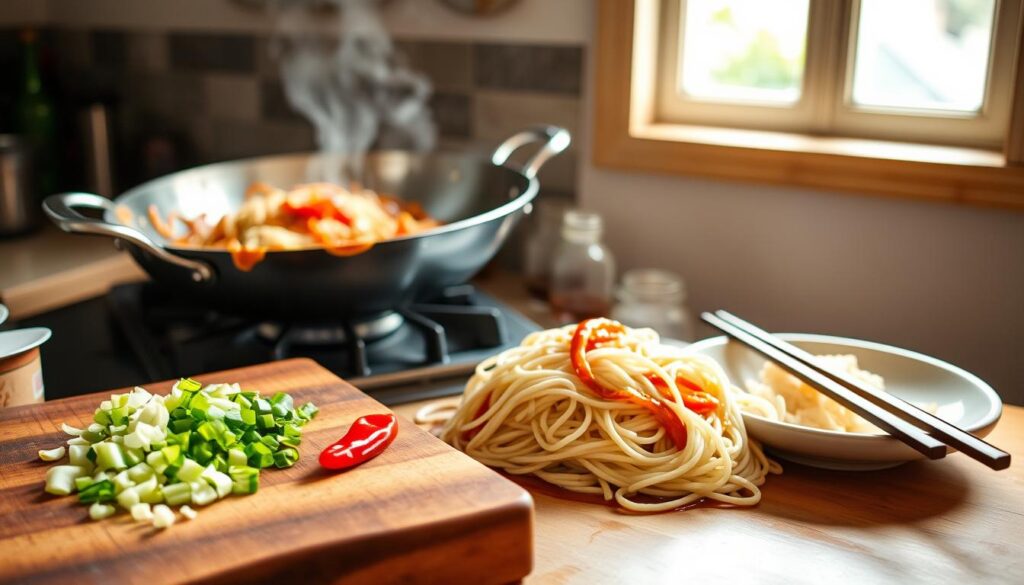
Prepping Aromatics and Sauces
Start by mincing 3 garlic cloves and thinly slicing 2 green onions. Combine these in a bowl with ½ tsp chili flakes. In a separate container, mix 1½ tbsp soy sauce, 1 tbsp rice vinegar, and ½ tsp sugar until dissolved.
Cooking Techniques for Perfectly Coated Noodles
- Boil udon or ramen noodles according to package instructions—stop 1 minute early for al dente texture
- Heat 3 tbsp neutral oil in a pan until it reaches 400°F (test with a wooden chopstick—bubbles mean it’s ready)
- Pour sizzling oil over your garlic-chili mixture, listening for that signature crackle
- Toss drained noodles in the pan with your infused oil and sauce base
- Stir-fry 2 minutes over high heat, using tongs to coat every strand
Finish with a drizzle of chili oil from the jar for extra sheen. Serve immediately while steaming hot, topped with crispy shallots. The high pan heat locks in flavors without making noodles greasy.
Tips, Customizations, and Expert Variations
Your bowl of chili oil noodles becomes a canvas for creativity. Personalize textures, heat levels, and ingredients to match your mood or dietary preferences. These simple tweaks keep the recipe exciting through countless iterations.
Enhancing Flavors with Garnishes and Additional Proteins
Boost visual appeal and texture with smart toppings. Try toasted sesame seeds for nuttiness or fresh cilantro leaves for brightness. For protein-packed versions:
- Shredded rotisserie chicken adds hearty substance
- Crispy tofu cubes create vegetarian crunch
- Fried eggs introduce creamy yolk richness
Storing, Reheating, and Adjusting Spice Levels
Keep leftovers fresh by storing noodles and sauce separately. Microwave portions with 1 tbsp water to revive texture. Control heat by:
- Reducing chili flakes by half for mild versions
- Adding honey to counterbalance fieriness
- Using less oil in the initial sauce mix
Creative Twists to Suit Your Taste
Swap soy sauce with tamari for gluten-free needs. Stir in peanut butter for creamy richness or lime zest for citrusy zing. Sauté mushrooms with garlic for earthy depth. This quick easy base adapts to whatever ingredients inspire you.
Conclusion
When hunger strikes but time is tight, this 10-minute noodle dish proves fast meals can thrill your taste buds. With its fiery chili-infused oil and savory-sweet sauce, every bite delivers bold flavor without complicated steps. The beauty lies in its flexibility—swap ingredients based on what’s in your pantry or spice tolerance.
Thick udon strands soak up the garlicky sauce beautifully, but ramen or rice noodles work just as well. Customize with extra veggies, proteins, or a sprinkle of sesame seeds for crunch. Perfect for rushed evenings or lazy weekends, it turns basic ingredients into something extraordinary.
Ready to make it your own? Whip up a batch tonight and tag your creations online—we’d love to see your twists. Bookmark this recipe for those nights when speed and satisfaction matter equally. Your future self will thank you.
FAQ
Can I use ramen noodles instead of udon?
Yes! Ramen noodles work well for this recipe. Adjust cooking time based on the package instructions to avoid overcooking. Wheat-based or soba noodles are also great alternatives.
How do I reduce the spice level without losing flavor?
Lower the amount of chili crisp or flakes, and balance the heat with a touch of sweetness using sweet soy sauce or a pinch of sugar. Toasted sesame seeds add richness without spice.
Can I make this dish ahead of time?
While best served fresh, cooked noodles can be stored in an airtight container for up to 2 days. Reheat gently in a pan with a splash of water or sesame oil to revive the texture.
What’s a substitute for rice vinegar?
Apple cider vinegar or lime juice adds a similar tangy brightness. For a milder acidity, try mirin or a dash of lemon juice mixed with a pinch of sugar.
How can I add more protein to this recipe?
Stir-fry shrimp, tofu, or thinly sliced chicken with the aromatics. A fried egg or crispy tofu cubes also pair well with the chili oil sauce.
Is there a gluten-free option?
Use tamari instead of soy sauce and gluten-free udon or rice noodles. Check labels on chili crisp and sauces to ensure they’re gluten-free.
Can I freeze leftovers?
Freezing isn’t recommended, as the noodles may become mushy. For meal prep, store sauces and cooked noodles separately, then combine when ready to eat.
What’s the best way to prep garlic and green onion quickly?
Use pre-minced garlic or a garlic press. Slice green onions with kitchen shears for faster prep. Pre-chopped veggies save time without sacrificing flavor.

